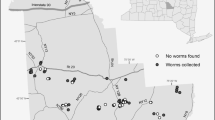Abstract
Although ample research exists on the ecological impacts of earthworm invasion in the Great Lakes region and northern hardwood forests, little data is available on the presence, distribution, and impact of earthworms in the prairies of the Northern Tallgrass Prairie. Sampling in a Northern Tallgrass Prairie fragment yielded three species of invasive earthworms occupying three different functional groups: surface and litter dwellers (epigeic), subsurface horizontal burrowers (endogeic), and deep vertical bore inhabitants (anecic). This research note illustrates the presence of non-native and potentially invasive earthworms in Northern Tallgrass Prairie.

Similar content being viewed by others
References
Alban DH, Berry EC (1994) Effects of earthworm invasion on morphology, carbon, and nitrogen of a forest soil. Appl Soil Ecol 1:243–249
Bohlen PJ, Scheu S, Hale CM et al (2004) Non-native invasive earthworms as agents of change in northern temperate forests. Front Ecol Environ 2:427–435
Bouché MB (1977) Strategies lombriciennes. Ecol Bull 25:122–132
Buntley G, Papendick R (1960) Worm-worked soils of eastern South Dakota, their morphology and classification. Soil Sci Soc Am J 24:128–132
Cameron EK, Bayne EM, Coltman DW (2008) Genetic structure of invasive earthworms Dendrobaena octaedra in the boreal forest of Alberta: insights into introduction mechanisms. Mol Ecol 17:1189–1197
Cassin CM, Kotanen PM (2016) Invasive earthworms as seed predators of temperate forest plants. Biol Invasions 18:1567–1580
Eisenhauer N, Scheu S (2008) Invasibility of Experimental grassland communities: the role of earthworms, plant functional group identity and seed size. Oikos 117:1026–1036
Groffman PM, Fahey TJ, Fisk MC et al (2015) Earthworms increase soil microbial biomass carrying capacity and nitrogen retention in northern hardwood forests. Soil Biol Biochem 87:51–58
Hale CM (2007) Earthworms of the great lakes. Kollath Stensaas, Duluth
Hale CM, Frelich LE, Reich PB (2005a) Exotic European earthworm invasion dynamics in northern hardwood forests of Minnesota, USA. Ecol Appl 15:848–860
Hale CM, Frelich LE, Reich PB et al (2005b) Effects of European earthworm invasion on soil characteristics in northern hardwood forests of Minnesota, USA. Ecosystems 8:911–927
Hale CM, Frelich LE, Reich PB (2006) Changes in hardwood forest understory plant communities in response to European earthworm invasions. Ecology 87:1637–1649
Iannone BV III, Umek LG, Wise DH et al (2012) A simple, safe, and effective sampling technique for investigating earthworm communities in woodland soils: implications for citizen science. Nat Areas J 32:283–292
James SW (1991) Soil, nitrogen, phosphorus, and organic matter processing by earthworms in Tallgrass Prairie. Ecology 72:2101–2109
Li X, Fisk MC, Fahey TJ et al (2002) Influence of earthworm invasion on soil microbial biomass and activity in a northern hardwood forest. Soil Biol Biochem 34:1929–1937
Loss SR, Blair RB (2011) reduced density and nest survival of ground-nesting songbirds relative to earthworm invasions in northern hardwood forests. Conserv Biol 25:983–992
Maerz JC, Nuzzo VA, Blossey B (2009) Declines in woodland salamander abundance associated with non-native earthworm and plant invasions. Conserv Biol 23:975–981
Nuzzo VA, Maerz JC, Blossey B (2009) Earthworm invasion as the driving force behind plant invasion and community change in northeastern North American forests. Conserv Biol 23:966–974
Resner K, Yoo K, Hale C et al (2011) Elemental and mineralogical changes in soils due to bioturbation along an earthworm invasion chronosequence in Northern Minnesota. Appl Geochem 26:S127–S131
Reynolds WJ (1977) The earthworms (Lumbricidae and Sparganophilidae) of Ontario (Royal Ontario Museum life sciences miscellaneous publication). Royal Ontario Museum, Toronto
Samson FB, Knopf FL, Ostlie WR (2004) Great plains ecosystems: past, present, and future. Wildl Soc Bull 32:6–15
Thorp J (1948) How soils develop under grass. In: Stefferud A (ed) Grass: the yearbook of agriculture. USDA Press, Washington DC, pp 55–66
Acknowledgements
This work was supported by the Agriculture Research Station at South Dakota State University. The fieldwork was cheerfully done by students in the Biological Invasion class of 2015 at South Dakota State University.
Author information
Authors and Affiliations
Corresponding author
Rights and permissions
About this article
Cite this article
Henshue, N., Mordhorst, C. & Perkins, L. Invasive earthworms in a Northern Great Plains prairie fragment. Biol Invasions 20, 29–32 (2018). https://doi.org/10.1007/s10530-017-1509-y
Received:
Accepted:
Published:
Issue Date:
DOI: https://doi.org/10.1007/s10530-017-1509-y




